|
|
Preliminary hints to Amateur Lecturers |
| In an old magazine I found this interesting - and in our days rather amusing - article on preliminary hints to Amateur Lecturers. |
|
|
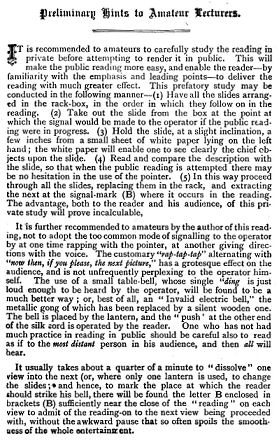 |
It is recommended to amateurs to carefully study the reading in private
before attempting to render it in public. This will make
the public reading more easy, and enable the reader -by familiarity with the emphasis and leading points- to deliver the
reading with much greater effect. This prefatory study may be conducted in the following manner-
(1) Have all the slides arranged in the rack-box, in the order in which they follow on in the reading.
(2) Take out the slide from the box at the point at which the signal would be made to the operator if the public reading
were in progress.
(3) Hold the slide, at a slight inclination, a few inches from a small sheet of white paper lying on the left hand; the
white paper will enable one to see clearly the chief objects upon the slide. (4) Read and compare the description with the
slide, so that when the public reading is attempted there may be no hesitation in the use of the pointer.
(5) In this way proceed through all the slides, replacing them in the rack, and extracting the next at the signal-mark
(B) where it occurs in the reading. The advantage, both to the reader and his audience, of this private study will prove
incalculable.
It is further recommended to amateurs by the author of this reading, not to adopt the too common mode of signalling to the operator by at one time rapping with the pointer, at another giving directions with the voice. The customary 'rap-tap-tap' alternating with 'now then, if you please, the next picture,' has a grotesque effect on the audience, and is not unfrequently perplexing to the operator himself. The use of a small table-bell, whose single 'ding' is just loud enough to be heard by the operator, will be found to be a much better way; or, best of all, an " Invalid electric bell," the metallic gong of which has been replaced by a silent wooden one. The bell is placed by the lantern, and the 'push' at the other end of the silk cord is operated by the reader. One who has not had much practice in reading in public should be careful also to read as if to the most distant person in his audience, and then all will hear. |
|
| It usually takes about a quarter of a minute to "dissolve" one view into the next or, where only one lantern is used, to change the slides ; and hence, to mark the place at which the reader should strike his bell, there will be found the letter B enclosed in brackets (B) sufficiently near the close of the ''reading" on each view to admit of the reading-on to the next view being proceeded with, without the awkward pause that so often spoils the smoothness of the whole entertainment. |
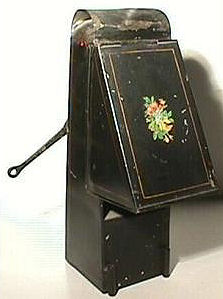 |
|
| Right: Fine original Magic Lanternist's reading/preview lamp with floral decorated/gold pinstriped exterior. | ||
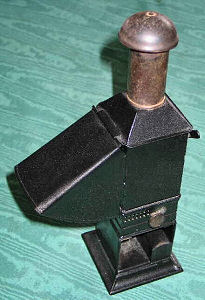
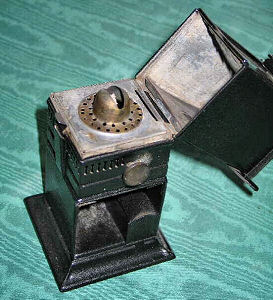
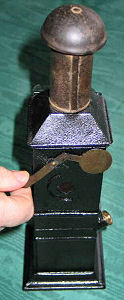 |
Magic Lantern Lecturer's Oil
Lamp from around 1890 - 1900. The lamp operates from kerosene (paraffin) oil and will burn for about an hour or so on a filling. On the back there is a red signalling glass which can be exposed by raising a brass shutter. This was used to give the projectionist an optical sign to put up the next slide. In most cases also a simple bell was built in to give the operator an audible sign. 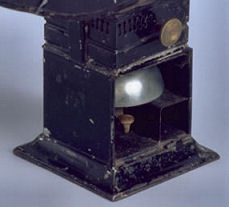
The lecturer's papers are illuminated by a shaded light from the lamp. The lamp has an opening shield which directs the light downward. A glass keeps the flame away from the papers. The flame is drawn up toward the chimney by air flow from beneath. The lamp is 12" tall. |
|
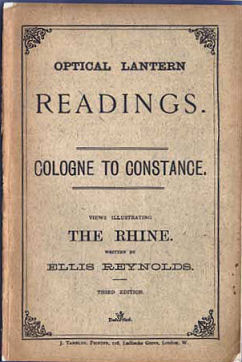 |
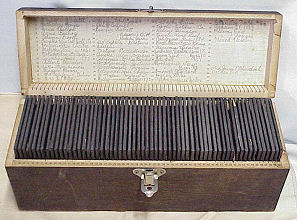 |
|
| Optical Lantern reading
produced to accompany a set of 60 slides depicting the Rhine from Cologne to Constance. |
||
| |
©1997-2021 'de Luikerwaal' All rights reserved. Last update: 05-06-2021. |
|